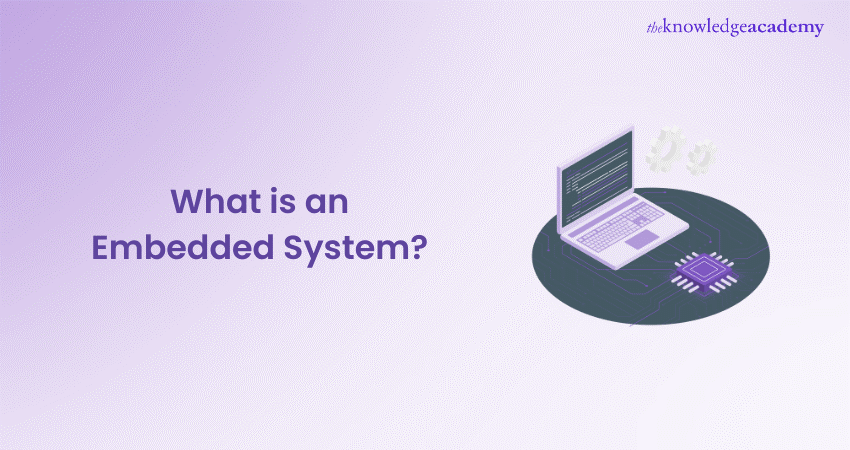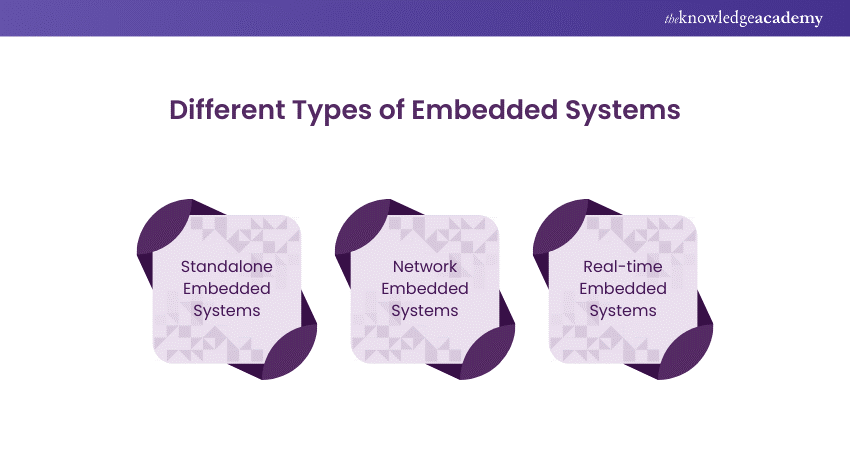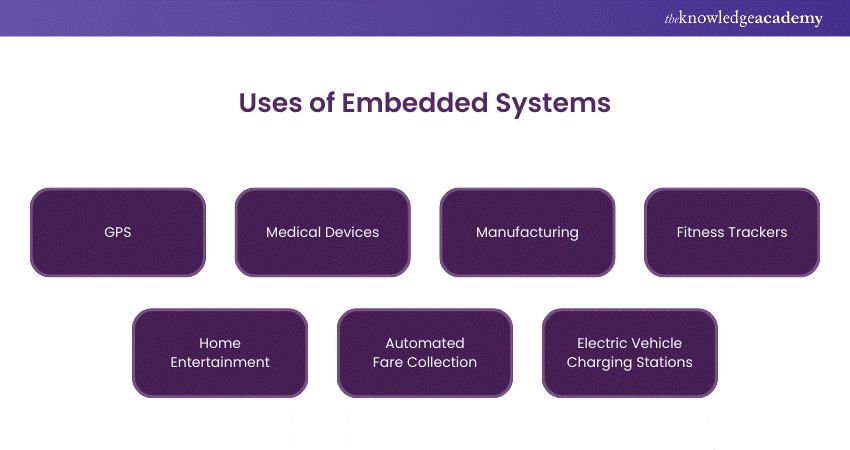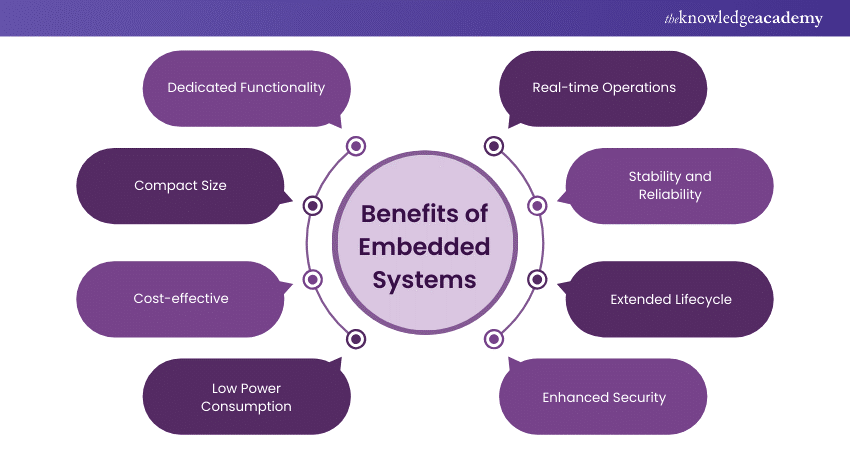We may not have the course you’re looking for. If you enquire or give us a call on +48 221041849 and speak to our training experts, we may still be able to help with your training requirements.
Training Outcomes Within Your Budget!
We ensure quality, budget-alignment, and timely delivery by our expert instructors.

Imagine a world where your car drives itself, your home adjusts the temperature before you even step inside, and your smartwatch monitors your health in real time. This isn’t a scene from a science fiction movie—it’s our modern reality, thanks to Embedded Systems.
Embedded Systems are small computers designed to perform specific tasks efficiently and reliably, often operating seamlessly in the background. In this blog, we’ll explore what Embedded Systems are and how they benefit various industries.
Table of Contents
1) What are Embedded Systems?
2) How do Embedded Systems Work?
3) Key Characteristics of Embedded Systems
4) Different Types of Embedded Systems
5) Components of Embedded Systems
6) Uses of Embedded Systems
7) Benefits of Embedded Systems
8) Emerging Trends in Embedded Systems
9) Conclusion
What are Embedded Systems?
An Embedded System is a compact computer incorporated into a more extensive system, device, or machine. Its primary function is to control the device and promote user interaction. Typically, these systems are designed to fulfil one or more tasks.
Embedded devices are not usually user-programmable; the manufacturer pre-installed their software. However, software updates are often possible. For instance, fitness trackers are Embedded Systems that gets upgraded by connecting it to a PC and installing new software.
Embedded Systems provide certain advantages over general-purpose computers:
a) Their limited functions make them less costly to design and produce
b) They typically consume less supply, with some devices running on batteries
c) They need minimal processing power, allowing for using cost-effective, lower-powered processors
Embedded Systems are used in applications with cost, power, size or weight constraints.
How do Embedded Systems Work?
Embedded Systems always function in coordination with larger devices. These small, low-cost, and energy-efficient computers are incorporated into mechanical or electrical systems. They typically contain a processor, power supply, memory, and transmission ports.
The ports exchange data between the processor and peripheral devices through specific communication protocols. The processor analyses this data using minimal software stored in memory, designed to the Embedded System’s exact function.
Embedded Systems often communicate with external systems within a device, enabling data transmission and control. The processor can either be a microprocessor or a microcontroller. Microcontrollers possess peripheral interfaces and integrated memory, while microprocessors need separate integrated circuits for functioning. Due to this lack of integration, microprocessors often need more support circuitry than microcontrollers.
A System-on-a-Chip (SoC) combines multiple processors and interfaces on one chip and is used in high-volume Embedded Systems. Common SoC types are Application-specific Integrated Circuits (ASICs) and Field-programmable Gate Arrays (FPGAs).
Embedded Systems are frequently found in real-time operating conditions, where they depend on Real-time Operating Systems (RTOS) for hardware interactions. In higher-level chip capabilities, near-real-time approaches are commonly used, with tasks that bear slight variations in response time.
To meet such requirements, stripped-down versions of Linux, Embedded Java, and Microsoft Windows IoT are often deployed on these systems.
Become a coding expert! Join our C Programming Training now and boost your career prospects. Register today to get started!
Key Characteristics of Embedded Systems
The primary feature of Embedded Systems is that they are designed for specific tasks. They often exhibit the following additional characteristics:
a) Components: They typically consist of hardware, software, and firmware.
b) Specialised Functions: Embed inside a larger system to complete specialised functions rather than handling multiple tasks.
c) Hardware Variants: Embedded Systems can be powered by either microprocessors or microcontrollers, both of which are integrated circuits that provide the system with computing capability.
d) SoC Utilisation: They frequently utilise ASIC and FPGA SoCs.
e) IoT Applications: Embedded Systems are commonly used for sensing and real-time computing in Internet of Things (IoT) devices, which are internet-connected and operate without direct user input.
f) Complexity Variability: Their complexity and functionality can vary, influencing the type of software, firmware, and hardware required.
g) Time Constraints: They often need to operate under time constraints to ensure the proper functioning of the larger system they support.
Different Types of Embedded Systems
Embedded Systems can vary from having no user interface to complex graphical user interfaces or even remote interfaces. The following are the different types of Embedded Systems:

1) Standalone Embedded Systems
These systems work independently without depending on a host system. They accept inputs, either analogue or digital, and deliver outputs. Examples include microwave ovens, MP3 players, and calculators.
2) Network Embedded Systems
Network Embedded Systems possess network connectivity in addition to typical Embedded System components. Their software architecture varies slightly, using real-time operating systems to handle network hardware. They get linked to a wired or wireless network and transmit data with an embedded web server, providing output to connected devices. Examples include card swipe machines, ATMs, and home security systems.
3) Real-time Embedded Systems
Real-time systems operate based on real-time computing using a Reliable Operating System (RTOS). They are categorised into two types, soft and hard, depending on how they manage time constraints.
4) Soft Real-time Systems
In these systems, operations degrade when results are not delivered within the specified time frame. Bypassing a deadline occasionally is acceptable, but regular delays can worsen performance, eventually making the system useless.
5) Hard Real-time Systems
Here, meeting the timeline is essential, and any variation from the deadline is unacceptable. These systems do not use permanent memory; they demand processes to be completed correctly on the first attempt. They must produce accurate responses to events within a fixed time frame, making them rigidly time-constrained and deterministic.
Components of Embedded Systems
The hardware components of Embedded Systems contain various physical elements that make up the system's infrastructure. These are power supplies.
1) Hardware Elements
The hardware components of Embedded Systems contain various physical elements that make up the system's infrastructure. These are power supply
a) Microcontrollers or Microprocessors
b) Memory
c) Timers
d) Counters
e) Communication Interfaces
f) Input/Output (I/O) Devices
g) Electrical Circuits
Together, these parts ensure the Embedded System fulfils its intended functions efficiently.
2) Software Elements
Unlike computer software, which can be installed on different devices to complete the same tasks, Embedded System software is uniquely developed for a specific device with a much more focused goal. The software components of Embedded Systems include:
a) Text Editor
b) Compiler
c) Assembler
d) Emulator
e) Link Editor
f) Debugger
These elements are highly specialised and created to complete specific tasks efficiently within the device constraints they control.
Uses of Embedded Systems
Embedded Systems are used in various modern technologies, including the Internet of Things (IoT) and Machine-to-Machine (M2M) devices. Below are a few real-world Embedded Systems applications:

1) GPS
The Global Positioning System (GPS) use satellites and receivers to synchronise location, velocity, and time-related data, offering a global navigation system. GPS receivers in cars and mobile devices are combined with Embedded Systems, allowing the use of GPS technology.
2) Medical Devices
Advanced medical devices incorporate Embedded Systems for continuous patient monitoring. Embedded sensors gather data related to health, such as heart rate, oxygen level, and blood sugar, and send it to a private cloud for automatic analysis or manual review by medical experts.
3) Manufacturing
Modern factories use robots/machines for high-precision tasks or to function successfully in hazardous conditions. These robots have sensors, actuators, and Embedded Systems to sense their surroundings and complete tasks safely and efficiently. As Industry 4.0 advances, plant automation systems increasingly combine Embedded Systems, Artificial Intelligence, and Machine Learning to improve safety, efficiency, and accuracy.
4) Fitness Trackers
Wearable fitness trackers oversee health metrics like heart rate, body temperature, and steps. These devices utilise Embedded Systems to accumulate data and transmit it via a Wide Area Network (WAN).
5) Home Entertainment
Embedded Systems are vital in-home entertainment devices like televisions. They take in commands from connectors such as HDMI, DisplayPort, and Ethernet, while remote controls transmit infrared signals for communication. Smart TVs are built with operating systems that support streaming and internet functions, and they depend heavily on Embedded Systems for increased functionality.
6) Automated Fare Collection
ATMs are large electronic devices commonly used in banking. They communicate with the bank’s computer system during exchange of money. Embedded Systems in ATMs take user inputs, process transaction data, and show the information regained from the bank's computer.
7) Electric Vehicle Charging Stations
Electric vehicle charging stations help in recharging EV batteries. Embedded Systems within the stations handle graphic displays, notice technical issues, and alert technicians about upcoming maintenance, ensuring streamlined operation.
Master C Programming and become coding expert with our C Programming Course – Register now!
Benefits of Embedded Systems
Here are some of the advantages of Embedded Systems:

a) Dedicated Functionality: Developed for specific tasks, ensuring optimised and efficient implementation.
b) Compact Size: Their compact size allows effortless integration into a wide range of devices.
c) Cost-effective: Specialisation minimises costs in comparison to general-purpose computers.
d) Low Power Consumption: Designed to operate with low power, making them energy efficient.
e) Real-time Operations: Capable of giving real-time feedback, which is vital for applications like medical devices and automotive systems.
f) Stability and Reliability: Completing specific tasks without regular updates leads to stable and trustworthy operations.
g) Extended Lifecycle: Often survive general-purpose computers due to their accurate design.
h) Enhanced Security: Limited functionality lessens vulnerabilities, enhancing security in some cases.
i) High Performance: Optimised for fast responses and operation due to dedicated functionality.
j) Ease of Management: Embedded Systems are simpler compared to full-scale computers, making management and maintenance easier.
k) Customisable: This can be customised to meet the requirements of a particular application or system.
Emerging Trends in Embedded Systems
The Embedded Systems industry is expected to grow rapidly, fueled by advancements in Augmented Reality (AR), Deep Learning, Artificial Intelligence (AI), Virtual Reality (VR), Machine Learning, and the Internet of Things (IoT). Cognitive Embedded Systems will play a major role in evolving trends, including reduced energy consumption, improved security for embedded gadgets, cloud connectivity, networking, Deep Learning applications, and real-time Data Visualisation tools.
Learn to build real-time applications with our Introduction Of Embedded C Programming today!
Conclusion
Embedded Systems are an integral part of our modern technology, providing efficient, cost-effective, and lasting solutions across various industries. Their rigorous design allows for real-time operations, low supply consumption, and improved security, making them crucial in applications ranging from medical devices to IoT and automotive systems. As advancements in Artificial Intelligence, Machine Learning, and IoT continue to flourish, Embedded Systems will continue to lead the next-gen smart technology.
Learn Object-oriented techniques with our C++ Programming (C Plus Plus) Course – Join now!
Frequently Asked Questions

The goal of an Embedded System is to complete specific, dedicated tasks within an extensive system, optimising performance and efficiency while working with minimal power and resources.

No, a laptop can't be called an Embedded System. It is a general-purpose computer developed to perform a comprehensive range of operations, unlike Embedded Systems which are task oriented.

The Knowledge Academy takes global learning to new heights, offering over 30,000 online courses across 490+ locations in 220 countries. This expansive reach ensures accessibility and convenience for learners worldwide.
Alongside our diverse Online Course Catalogue, encompassing 19 major categories, we go the extra mile by providing a plethora of free educational Online Resources like News updates, Blogs, videos, webinars, and interview questions. Tailoring learning experiences further, professionals can maximise value with customisable Course Bundles of TKA.

The Knowledge Academy’s Knowledge Pass, a prepaid voucher, adds another layer of flexibility, allowing course bookings over a 12-month period. Join us on a journey where education knows no bounds.

The Knowledge Academy offers various C Programming Courses, including the Introduction of Embedded C Programming Course, C# Programming Course, and C++ Programming Course. These courses cater to different skill levels, providing comprehensive insights into What is C Programming.
Our Programming & DevOps Blogs cover a range of topics related to Computing, offering valuable resources, best practices, and industry insights. Whether you are a beginner or looking to advance your Programming skills, The Knowledge Academy's diverse courses and informative blogs have got you covered.
Upcoming Programming & DevOps Resources Batches & Dates
Date
 C Programming
C Programming
Thu 19th Dec 2024
Thu 23rd Jan 2025
Thu 20th Mar 2025
Thu 22nd May 2025
Thu 17th Jul 2025
Thu 18th Sep 2025
Thu 20th Nov 2025







 Top Rated Course
Top Rated Course



 If you wish to make any changes to your course, please
If you wish to make any changes to your course, please


